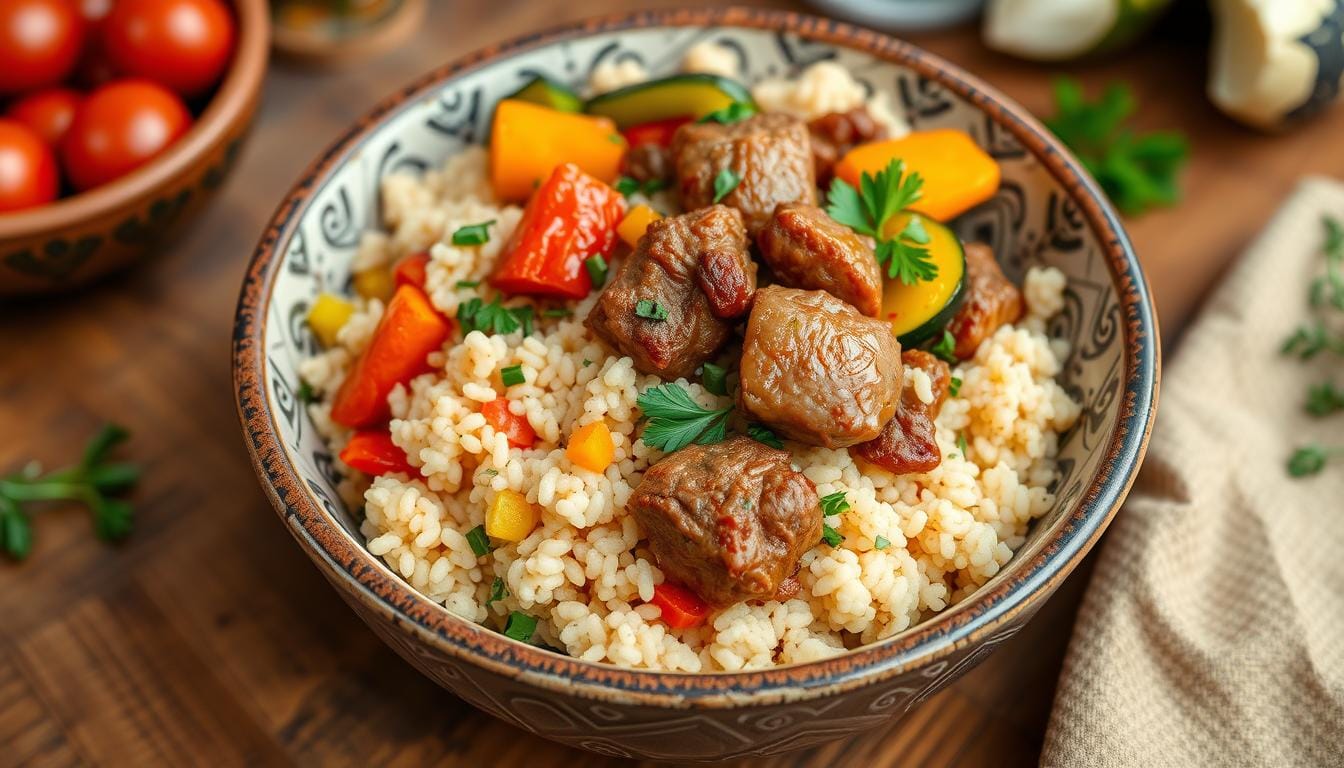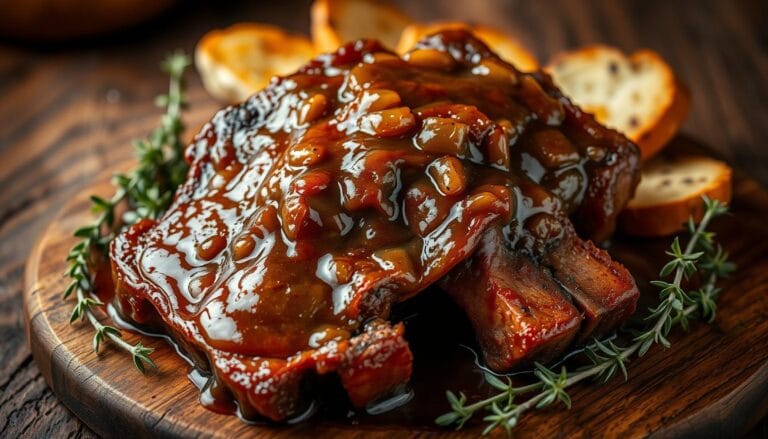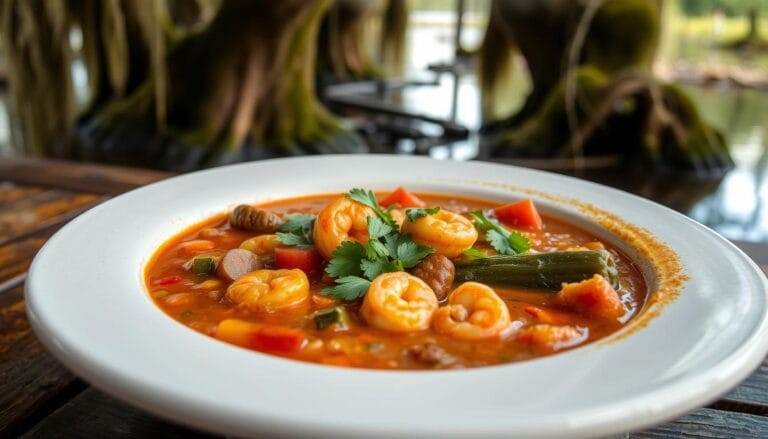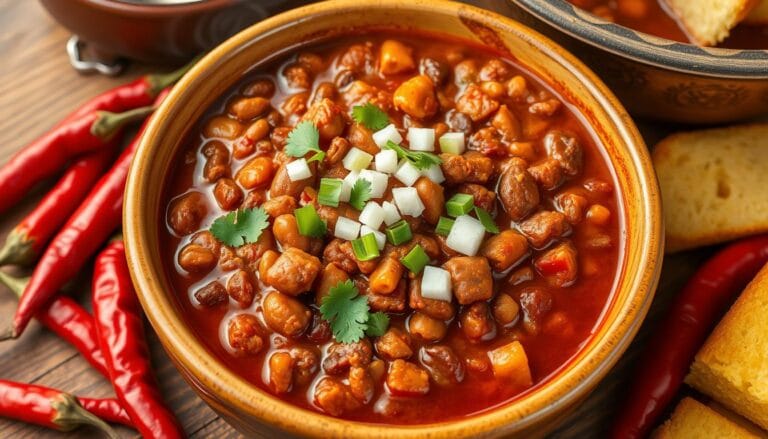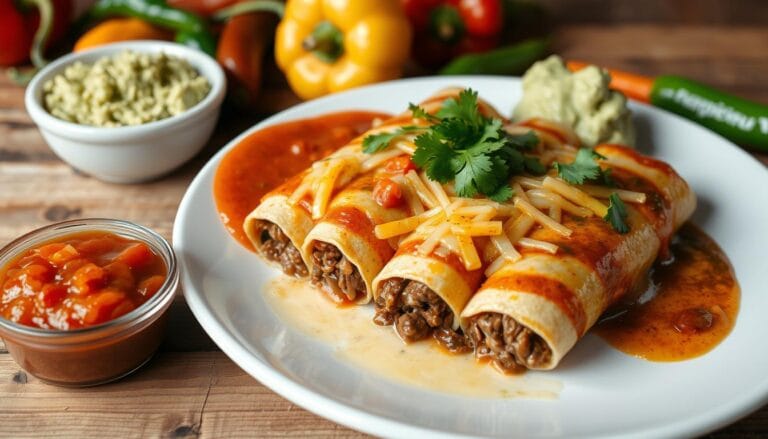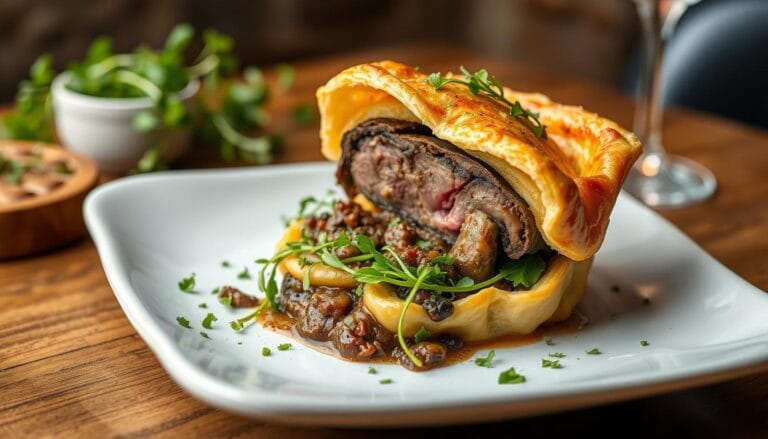7 Flavor-Packed Moroccan Couscous with Meat and Vegetables
Imagine being in a cozy kitchen, filled with the smells of a traditional Moroccan dish. You’re making a tasty Moroccan couscous with meat and vegetables. This recipe is a key part of North African food, and with our guide, you can make a dish that will wow your loved ones.
Starting this cooking adventure, you’ll learn about Moroccan cuisine’s rich history. You’ll also find out the key ingredients for a great couscous. This guide is for everyone, from experienced cooks to beginners. It will help you make a savory Moroccan couscous dish that will excite your taste buds.
Key Takeaways
- Learn how to make a traditional Moroccan dish with a delicious couscous recipe
- Discover the essential ingredients for a perfect moroccan couscous with meat and vegetables
- Understand the rich heritage of Moroccan cuisine and its cultural significance
- Get step-by-step instructions for preparing a mouthwatering Moroccan couscous dish
- Explore the various options for meat and vegetables to customize your couscous recipe
- Find tips and tricks for presenting your dish like a pro
The Rich Heritage of Moroccan Couscous
Exploring north african cuisine reveals the rich flavors and traditions of moroccan food. At its core is couscous, a dish cherished for generations. Understanding its origins and role in authentic moroccan recipe traditions is key.
Couscous’s history shows it has grown, shaped by cultures and trade. This evolution has enriched north african cuisine today. As you start your moroccan food journey, remember quality ingredients and love are crucial for an authentic moroccan recipe.
Couscous’s cultural importance in moroccan cuisine is significant. It’s served on special occasions, symbolizing hospitality and community. The traditional ways of serving couscous add to its charm, making meals unforgettable.

Origins of This North African Staple
Couscous’s roots are in north african cuisine. It’s been a key part of moroccan food for centuries, starting with the Berber tribes. Over time, it has grown, reflecting the region’s diverse cultures.
Cultural Significance in Moroccan Cuisine
In moroccan cuisine, couscous is more than food; it’s a symbol of warmth and hospitality. It’s a staple at family gatherings and celebrations, fostering community and connection.
Traditional Serving Customs
Serving couscous is a grand affair in moroccan food traditions. It’s placed in the center of the table, surrounded by various dishes. This colorful display is a key part of the authentic moroccan recipe experience, delighting the senses.
Essential Ingredients for Perfect Moroccan Couscous with Meat and Vegetables
To make authentic Moroccan couscous, you need the right ingredients. For homemade couscous, the type of couscous matters a lot. Traditional Moroccan couscous is made from durum wheat semolina, making it light and fluffy. You can find this at Middle Eastern or specialty stores.
For a tasty lamb and vegetable couscous, choose the freshest ingredients. You’ll need tender lamb, colorful vegetables, and aromatic spices. Important spices include cumin, coriander, and cinnamon. You can also add paprika, ginger, and turmeric for extra flavor.
When cooking couscous, use the right liquid and cooking time. Moroccan couscous is steamed over boiling water to keep it fluffy. Cooking it in lamb or vegetable stock adds extra flavor.
- Durum wheat semolina couscous
- Tender lamb or other meat of your choice
- A variety of colorful vegetables, such as carrots, zucchini, and bell peppers
- Aromatic spices, including cumin, coriander, and cinnamon
- Lamb or vegetable stock for added flavor
Choosing the Right Meat for Your Couscous
Choosing the right meat is key for a traditional Moroccan dish like couscous. You want a meat that complements the dish’s flavors and adds texture. Lamb is a classic choice for a true Moroccan taste.
Lamb is favored for couscous because of its rich flavor and tender texture. But, you can also try beef or chicken for a different taste. The goal is to balance flavors and cook the meat just right.
Lamb: The Traditional Choice
Lamb is a staple in Moroccan cooking. Its flavor goes well with Moroccan spices, making it perfect for couscous. To prepare lamb, marinate it with spices and herbs before cooking.
Alternative Meat Options
If you want to try something different, here are some options:
- Beef: Beef is a common choice for couscous, and you can use it alone or with lamb.
- Chicken: Chicken adds a lighter taste to couscous, great for those who prefer a leaner option.
No matter the meat, proper preparation is crucial for a delicious Moroccan dish. By following these tips and trying different meats, you’ll make a memorable Moroccan meal.
Selection and Preparation of Authentic Moroccan Vegetables
When making a traditional maroccan couscous with meat and vegetables, picking the right vegetables is key. For a tasty homemade couscous, choose carrots, zucchini, bell peppers, and onions. These are staples in Moroccan cooking.
To make these veggies taste great, chop, dice, and cook them right. Here’s how to prep them like a pro:
- Chop carrots and zucchini into small pieces for even cooking.
- Dice bell peppers and onions for color and flavor.
- Cook the veggies in olive oil and spices to boost their taste and smell.
By following these steps and using fresh Moroccan ingredients, you’ll make a dish that wows everyone. Mix the veggies with tender meat and fluffy couscous for the best taste and texture.
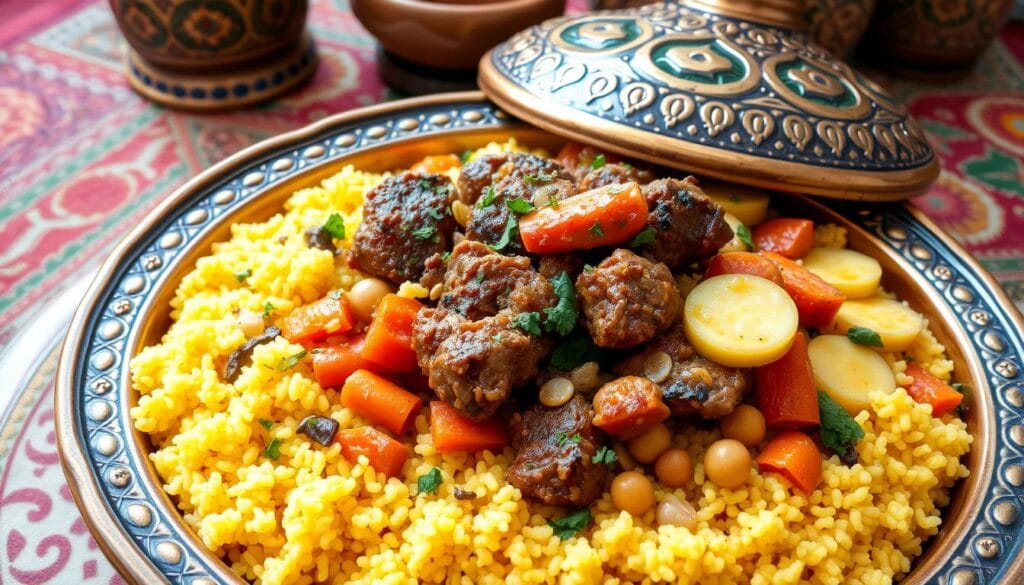
With practice and patience, you can make a delicious Moroccan couscous. It’s full of flavor and good for you. So, start cooking your own homemade couscous today!
Mastering the Art of Couscous Preparation
Exploring north african cuisine reveals that making couscous is an art. It needs patience, skill, and practice. To make a tasty couscous recipe, you must know the traditional steaming method and quick-cooking ways. We’ll show you how to cook couscous well, avoiding mistakes and getting a light, fluffy texture.
When cooking couscous, using the right techniques is key. This brings out the unique flavors and textures of this traditional dish. Here are some important tips:
- Use a steamer or a couscous pot to cook the couscous. This ensures even heat and prevents mushiness.
- Avoid overcooking the couscous. It should stay moist and tasty.
- Use the right amount of water. This helps achieve the perfect texture.
By following these tips and practicing, you’ll make a delicious and authentic north african cuisine dish. It will impress your friends and family. Always use fresh ingredients and try different flavors and spices to make your own couscous recipe.
With these tips and techniques, you’ll master couscous preparation. You’ll create tasty, authentic dishes that show off north african cuisine‘s flavors and traditions.
Essential Moroccan Spices and Seasonings
Preparing an authentic Moroccan recipe starts with the right spices and seasonings. Moroccan food is famous for its bold, aromatic flavors. These come from a mix of spices. To make tasty homemade couscous, you’ll need some key spices.
Cumin, coriander, cinnamon, and paprika are staples in Moroccan cooking. You can mix these spices to create unique blends. For example, cumin and coriander offer a warm, earthy taste. Cinnamon and paprika give a sweet, smoky flavor.
Traditional Spice Combinations
Here are some traditional Moroccan spice blends:
- Cumin and coriander for a warm and earthy flavor
- Cinnamon and paprika for a sweet and smoky taste
- Ginger and turmeric for a spicy and aromatic flavor
Creating Your Own Spice Blend
Feel free to experiment with your own spice blend. Mix different spices in various ratios to find your favorite flavor. You can also add garlic or onion powder for extra taste.
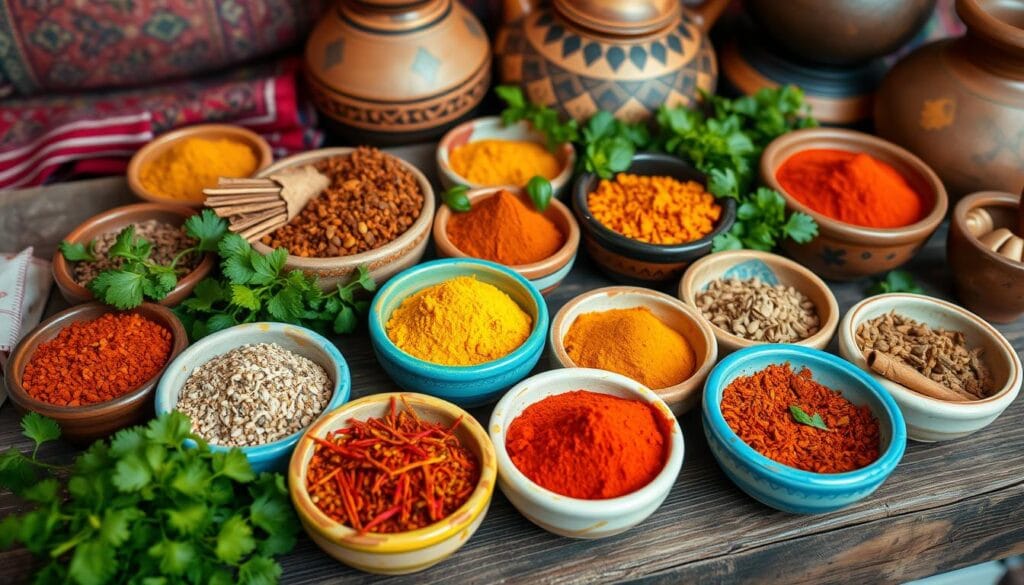
Using the right spices and seasonings makes any Moroccan recipe shine. Whether it’s homemade couscous or a new Moroccan dish, the right spices are key.
| Spice | Flavor | Usage |
|---|---|---|
| Cumin | Warm and earthy | Meat and vegetable dishes |
| Coriander | Warm and citrusy | Meat and vegetable dishes |
| Cinnamon | Sweet and spicy | Desserts and sweet dishes |
Step-by-Step Cooking Process
To make a tasty Moroccan couscous, follow these steps. Begin by cooking the couscous as per the couscous recipe. This means soaking it in water and then steaming it over a tasty broth.
Preparing the Base
When cooking couscous, use the right water amount and steam it for the right time. This makes the couscous soak up the broth’s flavors well. It also makes it light and fluffy.
Layering the Ingredients
After cooking the couscous, layer the ingredients on top. Add the maroccan couscous with meat and vegetables on the couscous. This balances the flavors and textures nicely.
- Use colorful vegetables to make the dish look good.
- Choose lamb or chicken as the meat to match the couscous’s flavors.
- Keep the vegetables crunchy by not overcooking them.
Final Assembly Tips
Finish the dish by adding final touches. Sprinkle parsley or add a dollop of yogurt. This brings all the flavors and textures together. You’ll get a delicious, authentic Moroccan couscous dish.
Serving and Presentation Guidelines
When serving a traditional Moroccan dish like couscous, presentation matters a lot. You want to make a dish that looks stunning and impresses your guests. Start by arranging the ingredients in a decorative pattern on a large platter or individual plates.
A traditional Moroccan recipe includes many vegetables, meats, and spices. Make sure to garnish with fresh herbs like parsley or cilantro. This adds color and freshness. You can also add lemon wedges on the side for extra flavor.
Here are a few tips to keep in mind when serving Moroccan food:
- Use a large, decorative platter or individual plates to add to the presentation
- Garnish with fresh herbs like parsley or cilantro
- Add a few lemon wedges on the side for extra flavor
- Consider serving with traditional Moroccan sides like harissa or preserved lemons
By following these simple tips, you can create a beautiful and delicious traditional Moroccan dish. It will impress your guests and leave them wanting more. Whether it’s for a large crowd or an intimate gathering, a traditional Moroccan recipe is sure to be a hit.
| Traditional Moroccan Dish | Moroccan Food | Authentic Moroccan Recipe |
|---|---|---|
| Couscous with Meat and Vegetables | Tagine, Harissa, Preserved Lemons | Traditional Spice Combinations, Fresh Herbs |
Traditional Accompaniments and Side Dishes
In north african cuisine, side dishes are key to a great meal. Exploring homemade couscous opens up a world of tasty options. You can enjoy salads, stews, dips, and drinks.
Classic Moroccan sides often feature cooking couscous with veggies, meats, and spices. Try it with a fresh salad of tomatoes, cucumbers, and feta. Or, go for a hearty stew with lamb or chicken, flavored with north african cuisine spices.
For drinks, Moroccan mint tea or north african cuisine-inspired wine are great choices. They refresh you and bring out the flavors of your homemade couscous. As you try different cooking couscous recipes, don’t be afraid to mix and match to find your favorite.
Classic Moroccan Sides
- Salads: mixed greens, tomatoes, cucumbers, and feta cheese
- Stews: lamb or chicken slow-cooked in a spicy broth
- Dips: creamy hummus or spicy harissa
Beverage Pairings
Whether you like hot mint tea or cold wine, the right drink makes your homemade couscous better. So, be adventurous and find your ideal match in north african cuisine and cooking couscous.
Conclusion: Embracing the Magic of Moroccan Cuisine
As we conclude this guide to making a delicious Moroccan couscous dish with meat and vegetables, we hope you’re excited. Moroccan cuisine is a journey filled with spices, textures, and traditions. It’s sure to make your taste buds dance.
Whether you’re an experienced chef or just starting out, we urge you to try Moroccan cooking. Explore new ingredients and techniques. This will help you create dishes that truly reflect Moroccan culture.
The true beauty of Moroccan cuisine is the journey, not just the end result. So, start your own culinary adventure. Let the smells and tastes of Morocco take you to a world of rich history and vibrant cultures.

